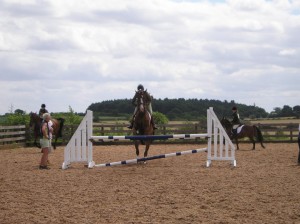The natural environment of the eventer does not include the show-jumping warm-up. In fact in a list of ‘Things Eventers Enjoy Doing’ warming up for the show-jumping ranks only just above trying to stud-up an over-excited horse with frozen fingers, stones in every stud hole and a bad back. Half an hour spent watching the show-jump warm-up ring at any event will demonstrate a range of behaviours from displacement activities (striking up a conversation with random strangers, fiddling with tack, lighting a fag) to opposition psyching (putting the oxer up to maximum permitted height and cutting everyone up on the approach) to pecking-order panics (I’m only an nobody, me. I’ll keep out of the way of the important people and if I get a chance to pop the X-pole before I go in I’ll be very grateful. Maybe I’ll just trot round a few times and keep out of the way instead). Most people’s warm-up strategy is the complete absence of any strategy.
I am either at an event on my own, with a friend or with my husband and my routine does tend to vary a little depending on what help I have.
When I’m on my own I usually go in and do any warming-up I want to do on the flat fairly quickly. Depending on which horse I’m on this might be lots of quick exercises to improve engagement in canter: some lateral work, some walk/canter transitions, transitions within the canter etc. or for another horse it might be some low stretchy trot, trying to keep it quiet and keep the energy levels down. Then comes the tricky bit. With no help you’re going to have to jump what others are jumping. The best way of doing this is to spot someone ready to jump and stalk them. Jump the X-pole a couple of times (this, at least, should stay at a sensible height) from trot or canter then follow your subject as they get their mummy or daddy or team of grooms to give them a smallish upright and oxer. If you should knock a pole down smile sweetly, say sorry and someone is bound to pick the pole up for you. Ignore the killer looks from the person who was following you and had to circle away at the last moment. Knocking the fence down occasionally is fine. Knock it down every time and you will rapidly find yourself extremely unpopular. It may also indicate that there is still a bit of work to be done at home!
With each horse I like to have a session at home occasionally where I set out three fences as you would find at an event and play with my warm-up routine, finding out what gets each horse jumping best. Some need a lot of fences, some only one or two; some need to clout a biggish fence to get them concentrating, others are better jumping a couple of small fences and going into the ring full of confidence. If I have a helper with me I can usually follow my plans to the letter when I get to an event. If I don’t I might find myself having to adapt my plans a bit to fit in. It’s important to develop the mental flexibility so that you don’t fall apart if you haven’t had exactly the fences you want in the order you want.
Don’t forget the rules: keep to the appropriately coloured tape heights on the wings for your class. No V-poles, sloping oxers or false ground lines. The back rail of the oxer shouldn’t be lower than the front (despite the fact that you might see certain professionals doing it, it’s against the rules). There are also the non-rules – don’t hog a particular fence, if you knock it down make sure someone picks it up or get off and do it yourself, take your turn to jump, but be assertive and make sure you get your turn.
The last thing to mention is the dreaded ‘board’. Every event seems to run this differently. Some will only let you jump in paper order (this will always be the case at FEI), others will take declarations when you enter the warm-up. Most SJ stewards are amazing and run their board with an iron fist in a velvet glove, some are disorganised, not on the ball and happy to let people push in. They are all however volunteers so regardless of how well/badly they’re coping it’s our job to smile and thank them, even if it’s through gritted teeth. If you want an proper education in how it works volunteer to spend a day at an event running the warm-up ring. It’s an experience…
My favourite system is where you declare your number when you enter the warm-up and jump in that order. It means least hanging around and seems to keep the ring full and running as efficiently as possible. I have particular respect for Eland Lodge, where they run the tightest warm-up system I’ve encountered anywhere – only the next 4 or 5 riders are allowed in to have a practice jump and the steward shouts out the numbers in order every couple of minutes so everyone knows where they are. Whichever system is in operation it pays to pop over when you arrive at the event and check how they’re running it so that you save yourself a bit of time and stress later in the day.
Warming up for the show-jumping should be stress-free and if you think of it positively it will become a positive experience. Know what system is in operation and when you’re due to go in, have a plan for jumping which suits your horse, but be prepared to deviate from the plan if the circumstances dictate it. Don’t be distracted or intimidated by anyone else, just get in there, get the job done and get in to the ring with the best possible warm-up (mentally and physically) under your belt. That way clear rounds lie!







[…] pretty much covered the art of warming-up for the show-jumping on your own in this article. Getting ready for XC is easy as times are usually pretty close to the SJ times. Change boots, […]